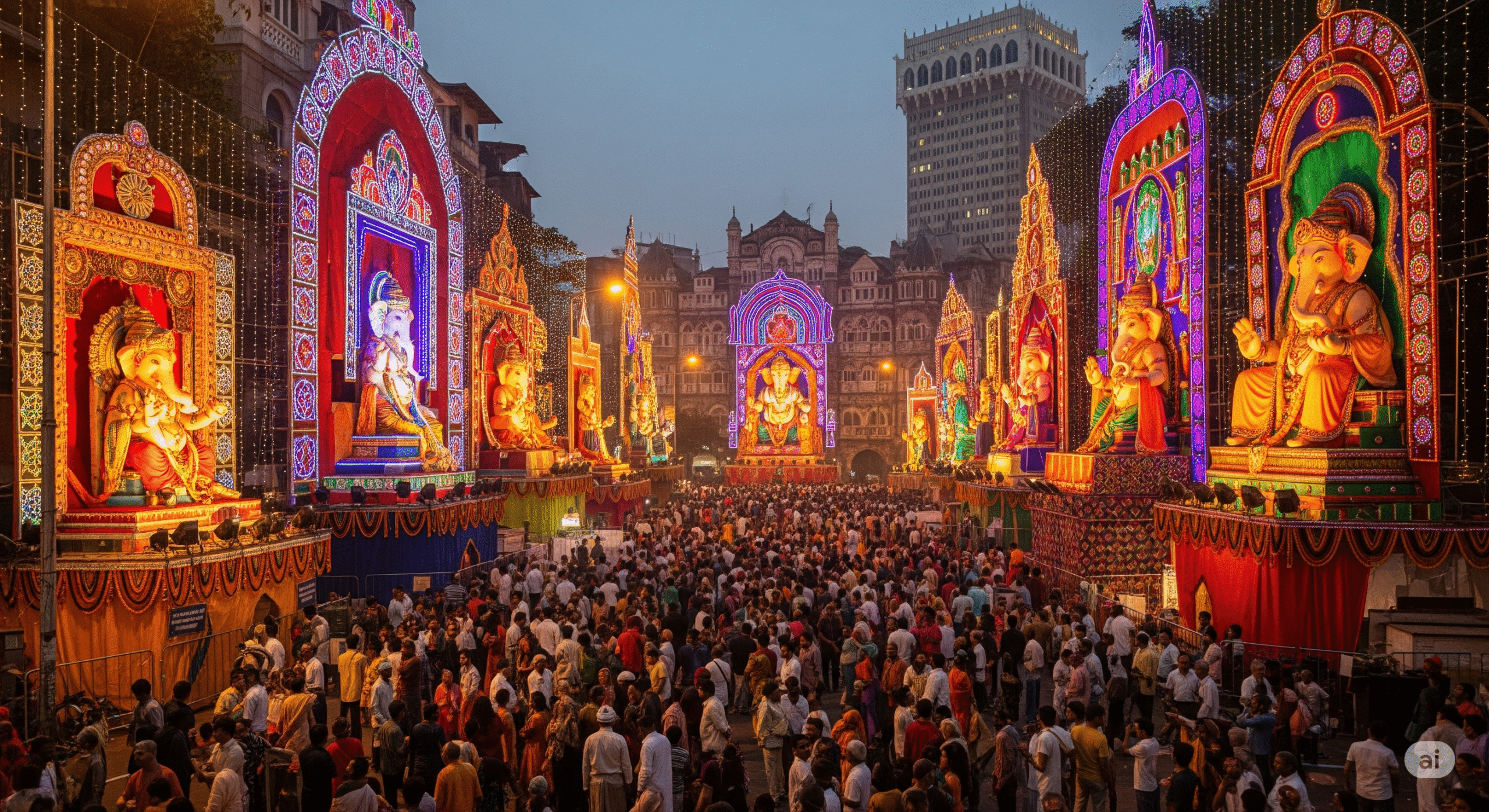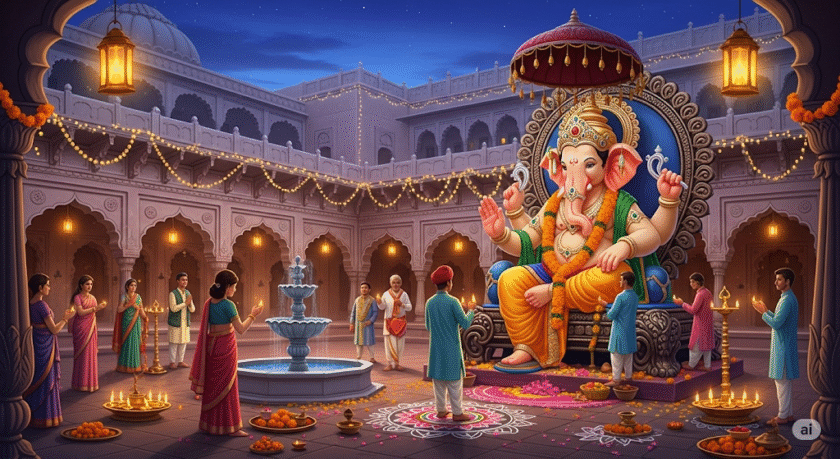Mumbai – The air in Mumbai, the bustling heart of India, is thick with an energy that is both spiritual and electric. As the monsoon rains have given way to clearer skies, the city is readying itself for its most anticipated celebration: Ganesh Chaturthi. This year, the 10-day festival, set to begin in September, promises to be a spectacle of unprecedented scale, blending ancient traditions with a modern, eco-conscious fervor. With an estimated 20,000 public pandals transforming the city’s landscape from the crowded lanes of Girgaon to the serene suburbs of Bandra, Mumbai is about to immerse itself in a divine wave of devotion, music, dance, and community spirit. From the meticulous crafting of divine idols to the innovative use of technology and sustainable practices, the preparations are a testament to Mumbai’s unyielding spirit of celebration. In this feature, we delve into how this dynamic metropolis is readying itself to bask in the glory of Lord Ganesha, showcasing a harmonious blend of faith, innovation, and cultural pride.
The Art of Idol Creation: Crafting the Divine Form
At the very core of Ganesh Chaturthi preparations lies the creation of Ganesha idols, a timeless craft that has evolved from humble clay figures to magnificent works of art. For months, Mumbai’s idol makers, or ‘kumhars,’ have been working tirelessly, with workshops in areas like Lalbaug, Parel, and Chembur buzzing with an almost hypnotic activity. The scent of fresh clay and natural dyes fills the air as skilled hands meticulously mold the divine form. This year, the focus on sustainability is more pronounced than ever, driven by the city’s rapidly growing environmental consciousness.
A prime example is the renowned Lalbaugcha Raja pandal, one of Mumbai’s oldest and most famous, established in 1934. Preparations here began as early as June, with veteran artisans sourcing red soil from the city’s creeks to mold the 21-foot-tall idol. “We use only natural clay mixed with hay and cow dung for authenticity and eco-friendliness,” explains Shankar Shinde, an artisan with over 40 years of experience. This commitment stands in stark contrast to the Plaster of Paris (PoP) idols that once dominated the festival, which could take years to dissolve in water and posed a significant threat to marine ecosystems. Today’s idols are almost entirely biodegradable, strictly adhering to the guidelines set by the Maharashtra Pollution Control Board (MPCB). The process is an intricate art form: Ganesha’s trunk is curved with precision using bamboo supports, his eyes are painted with non-toxic colors derived from vegetables and natural pigments, and his favorite accessories, modak (sweet dumplings), are handcrafted from dough.

Across the city, smaller workshops in Thane and Navi Mumbai are also embracing innovation. Artisans at the Siddhivinayak Murti Kendra, for instance, are incorporating LED lights and eco-friendly dyes to create idols that glow with a gentle aura during the evening aartis. With the festival’s sheer scale, estimated to involve the installation of over 1.5 million idols citywide, these preparations not only sustain the livelihoods of thousands of artisans but also serve as a powerful educational tool, teaching the public about the importance of environmental stewardship. Last year, Mumbai successfully recycled over 90% of the waste generated from idol immersion (visarjan), and this year, the Brihanmumbai Municipal Corporation (BMC) has deployed 200 special teams to ensure a smooth, pollution-free visarjan process. As the clay idols take their final shape, Mumbai’s skyline begins to shimmer with Ganesha’s benevolent gaze, a symbol of the removal of obstacles for the year ahead.
Pandals and Decorations: Transforming Streets into Sacred Spaces
No Ganesh Chaturthi is complete without the pandals—temporary shrines that transform ordinary neighborhoods into vibrant hubs of worship. Mumbai’s preparations for these structures are a testament to the city’s architectural ingenuity and deep-seated communal harmony. From the iconic Girgaoncha Ganpati, known for its towering 35-foot idol, to the celebrity-frequented Andheri pandals, each one is a true labor of love and community collaboration.
Preparations for these grand structures kick off weeks in advance, with local committees raising funds through a blend of traditional donations, corporate sponsorships, and even online crowdfunding campaigns. In Dadar, the GSB Seva Mandal pandal, famous for its elaborate theme-based decorations, has adopted a “Vedic Heritage” motif this year. Hundreds of dedicated volunteers have been working since August, meticulously erecting bamboo frameworks and adorning them with shimmering LED lights, floral arches, and large digital screens that play videos depicting ancient Ganesha mythology. “Our goal is to create an immersive experience for the devotees,” says organizer Priya Desai. “Visitors can experience virtual reality tours of ancient temples while offering their prayers.” Budgets for these pandals range from a modest Rs 5 lakhs for a local neighborhood setup to several crores for mega-pandals like Lalbaugcha Raja, which attracts over 1.5 million devotees daily, all seeking a glimpse of the revered deity.
Safety is of paramount importance amidst the festivities. The BMC and the Mumbai Fire Department have conducted extensive mock drills, ensuring that all pandals comply with strict load-bearing standards and are constructed using fire-retardant materials. In a progressive nod to inclusivity, many pandals now feature ramps for the differently-abled and have established women-led committees, reflecting Mumbai’s forward-thinking ethos. Suburbs like Borivali and Juhu are witnessing a surge in uniquely themed pandals—one committee has even recreated the Ayodhya Ram Mandir to blend the festivals in a harmonious display of faith. As night falls, these pandals light up with the warm glow of diyas and the flash of lasers, turning Mumbai into a breathtaking sea of gold, where devotees sway to the rhythmic beats of dhols and the soulful melodies of bhajans, fostering a profound sense of unity within the city’s diverse social fabric.
Cultural Programs and Community Engagement: The Soul of the Festival
Ganesh Chaturthi is far more than just religious rituals; it is a grand cultural extravaganza that unites Mumbai’s residents in shared joy and purpose. Preparations extend to organizing a wide array of events that celebrate art, music, and important social causes. Community centers in areas like Matunga and Worli are bustling with rehearsals for traditional performances, from energetic Lavani dances to elegant classical Bharatnatyam recitals dedicated to Lord Ganesha.
This year, Bollywood’s influence is more palpable than ever. Celebrities like Amitabh Bachchan and Vidya Balan have lent their support to various pandals, promising visits that are sure to draw massive crowds of fans and devotees alike. Preparations include the setup of stages for live concerts—think fusion bhajans inspired by artists like AR Rahman—and dramatic skits that bring Ganesha’s timeless tales to life. In Bandra, the Mount Mary Ganeshotsav Committee has planned a series of eco-awareness workshops alongside their cultural shows, teaching children about sustainable practices through engaging puppetry and storytelling.

Non-profit organizations are also heavily involved, with groups like the Rotary Club organizing blood donation drives and free health camps at the pandal sites. “Ganesh Chaturthi is about the removal of obstacles, including social ones,” notes activist Meera Iyer. “The festival provides a perfect platform for community service.” The reach of the festival has now become global, with online streaming platforms enabling the large Indian diaspora to participate in virtual aartis, bridging geographical divides. These community-led preparations not only amplify the sense of devotion but also serve to address urban issues like waste management and public health, making the festival a true catalyst for positive change in Mumbai’s fast-paced life.
Culinary Delights: Feasting in Ganesha’s Honor
No celebration in Mumbai is complete without food, and the preparations for Ganesh Chaturthi in kitchens across the city are in full swing. The festival’s culinary centerpiece is the modak, Lord Ganesha’s favorite sweet. In homes and sweet shops, artisans are busy perfecting this delicious delicacy. From the classic steamed ukadiche modak filled with a rich mixture of coconut and jaggery to the popular fried varieties, thousands are being churned out daily in Crawford Market and other food hubs.
The culinary preparations also align with the festival’s eco-conscious theme, with many opting for organic ingredients. In Matunga, the Tamilian and Maharashtrian communities are collaborating to prepare traditional festive dishes like sundal (spiced chickpeas) and puran poli (sweet flatbreads), reflecting the city’s multicultural harmony. Street vendors in Juhu and Dadar are also gearing up with stalls that meet stringent hygiene standards, offering festive twists on local favorites—like a festive vada pav topped with a modak-inspired chutney. For the larger pandals, professional catering teams are preparing prasadam for lakhs of devotees, using only biodegradable plates and utensils. This culinary frenzy not only delights the palate but also strengthens family and community bonds, as generations gather to cook together, sharing cherished recipes. As the irresistible aroma of ghee and cardamom wafts through the city, Mumbai’s food scene becomes a homage to the Vighnaharta, the remover of obstacles.
Environmental and Logistical Preparations: Ensuring a Green and Smooth Celebration
With Mumbai’s population swelling during the festival—estimated to attract an additional 5 million visitors—the city is ramping up its logistical preparations to ensure a safe and smooth experience for everyone. The Mumbai Police have deployed over 10,000 personnel, supported by drone surveillance over key pandals, to manage crowds and prevent any mishaps. To ease congestion, traffic diversions have been put in place in South Mumbai, and app-based tracking systems are being used for visarjan routes, a modern innovation aimed at improving efficiency.
Environmentally, the BMC’s “Green Ganpati” campaign is a central focus. Preparations include the setup of 50 artificial immersion tanks across the city to prevent pollution of the Arabian Sea. Clay idol distribution points have been established to promote eco-friendly alternatives to PoP, and awareness drives in schools highlight the negative impact of chemical dyes on marine life. NGOs like Earth5R are training volunteers for post-festival cleanups, aiming for zero-waste immersions. These concerted efforts ensure that while Mumbai basks in Ganesha’s glory, it does so responsibly, preserving the precious marine life of its coasts.
The Grand Visarjan: Culmination of Devotion
As the festival reaches its emotional climax on Anant Chaturdashi, preparations for the visarjan processions intensify. Trucks are decked with vibrant flowers, bands play the soulful shehnai, and devotees dance in ecstatic revelry as they accompany the idols on their final journey to the sea. In Girgaon, rehearsals for the mammoth procession, which can last for over 24 hours, have been ongoing. Along popular beaches like Juhu and Versova, safety boats and trained lifeguards are stationed to prevent any accidents.
This year, technology will also play a role in the grand farewell, with GPS-enabled apps guiding the processions to reduce congestion and ensure a more orderly flow. The final, emotional farewell, with resounding chants of “Ganapati Bappa Morya, Pudhchya varshi lavkar ya!” (O Lord Ganesha, come again soon next year!), encapsulates the cyclical nature of arrival and departure, mirroring life’s impermanence.
A City United in Faith
Mumbai’s preparations for Ganesh Chaturthi 2025 are a powerful symphony of tradition and modernity, devotion and innovation. From the clay kilns of Lalbaug to the digital screens of Andheri, every corner of the city pulses with a shared sense of anticipation. As Mumbai prepares to bask in Lord Ganesha’s glory, it reaffirms its identity as a vibrant melting pot of cultures, where faith transcends all barriers. This festival is not just a celebration; it’s a renewal, a promise of prosperity and joy. With its commitment to eco-conscious steps and a deep-seated communal zeal, Mumbai ensures that Bappa’s visit leaves a lasting, positive legacy for all.





